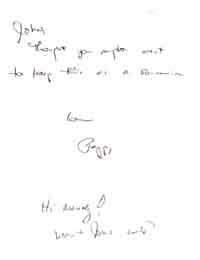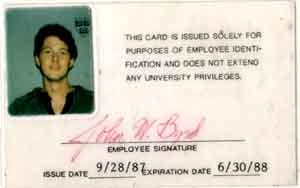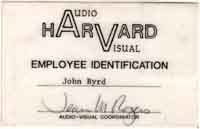INT. LOS ANGELES THEATER - DAY
Two actors shuffle scripts on a stage as a class of hopefuls
look on. The guru steeples her fingertips and nods.
JOHN
(reading)
It's a dress. Why won't you wear
it?
LINDA
(reading)
I hate it... I hate the way... you
proposed to me.
JOHN
(reading)
So what are you saying?
LINDA
(reading)
I'm saying that --
GURU
Okay, let's just stop. One of the
mistakes I see here is straight out
of theater, or rather, I should
say, community theater. There's no
connection. No connection at all.
You see how you're reading away
from one another? Totally amateur.
This is El Lay. That sort of thing
will get you kicked out of an
audition, quick quick quick. How
much fundamentals have you had?
LINDA
Um... I don't know?
GURU
You?
JOHN
What do you mean by fundamentals?
GURU
Ah. I see. Basic motivation.
Scene, counter-scene. Mind-sense
memory. I see so many actors come
in, so many actors across the
United States, and they don't have
their basics. You gotta ask the
fundamentals. In this scene, what
is it that you want? What do you
want to accomplish? How do you
feel? Do you love them? I run a
three-day workshop, by the way, on
these issues. We really get into
the details of the emotions. And
it's a non-judgemental place, I
tell you. A place for actors to
free themselves. And their
emotions. We accomplish some great
things there.
Guru holds up a booklet labelled "Art Is."
GURU
This is my book of poetry, it's
called "Art Is." "Art Is" came
from a pretty personal place, I can
tell you. I believe in the healing
power of acting. And I think that
comes through pretty clearly in the
poetry. That's the essence of
poetry, is Art. And Art Is. Well.
Let's start the scene again.
John and Linda shuffle pages.
JOHN
(reading)
It's a dress. Why won't you --
GURU
Okay, stop. I want you to look at
her, and say, "I love you, wear the
dress."
JOHN
I love you. Wear the dress.
GURU
Look at him. Say, "I love you, I
won't wear the dress."
LINDA
I love you. I won't wear the
dress.
GURU
Again.
JOHN
I love you. Wear the dress.
LINDA
I love you. I won't wear the
dress.
JOHN
(breathy)
I love you, wear the dress --
LINDA
(breathy)
I love you, I won't wear the dress
-
GURU
Start the scene.
JOHN
It's a dress. Why won't you wear
it?
LINDA
I hate it... I hate the way... you
proposed to me.
GURU
There, we have a connection. And
the most important part of the
connection is learning to play
love. How do you play love? How
do you play love for a person
you've never met before in your
life? It has to come from
somewhere. It has to come from a
personal experience. You have to
make it your own. I teach an
advanced course -- and granted,
you're still very new, but some of
my five-year and six-year students
make the cut -- where you can pop
in and out of love. This is the
key thing. This is what the
casting agents are looking for.
What if you don't love? Where's
the interest? I'm asking you a
question.
JOHN
Um...
FADE TO BLACK.
As you right well pointed out, actors are an insecure lot, roughly saddled with the need for artistic and personal validation. Given these market forces, and the number of fresh-faced young girls arriving in L.A. each summer, it’s impossible to imagine that a profitable artistic-guru industry would not spring up.
All professional acting gurus have a deep conflict of interest: I’ll tell you how to act, how to find your character and make your art and get rich and break into an upcoming Paramount Pictures release, so long as you buy my tapes and attend my workshops and and pay for my back office.
“Without talent or ability one must not go on the stage. In our organized schools of dramatic art it is not so today. What they need is a certain quantity of paying pupils.” That sounds like it was written two weeks ago, but Stanislavski actually wrote it in 1925.
There is no more important choice for the aspiring artist than the choice of guru. And most artists make this choice far too hastily. The math is simple: if you emulate a guru, you will, in the optimal case, achieve the results that the guru has achieved.
The acid test for any guru — religious, political, or artistic — should be the following: What have you done recently? Not what have your students done, not what did you do 30 years ago in a Boston regional theater, not what do you have a romantic vision of yourself doing… but, simply, what have you done recently?
Nearly all modern artistic gurus fail miserably by this standard. They tend to have recently published poetry on web sites, or at best, supervised three-day workshops.
If you don’t know how to do something, start by copying someone who does it with fine success, by your definition of what constitutes success.
Here are the artistic gurus that have been most influential on my life.
Everett Chambers. A short, curmudgeonly grumpus of a director, pushing seventy-five… crotchety, sharp and very, very funny. Directed me in two plays. The producer of the “Columbo” TV series and about a dozen movies-of-the-week, mostly for ABC. Directs on his feet.
Keith Johnstone. Wrote “Impro,” the most worthwhile book I’ve ever read on the acting process. Invented several key improvisation formats that morphed into popular television shows.
With this new litmus paper in hand, let’s return to letter three and our man Rilke. “Let me here promptly make a request: read as little as possible of aesthetic criticism — such things are either partisan views, petrified and grown senseless in their lifeless induration, or they are clever quibblings in which today one view wins and tomorrow the opposite. Works of art are of an infinite loneliness and with nothing so little to be reaches as with criticism. Only love can grasp and hold and be just towards them.” Rilke is oblivious to the fact that he himself is, in this very paragraph, writing aesthetic criticism. Were we to follow his instructions exactly, we should stop reading his letter right away.
But the most telling bit of the letter is not his general artistic advice — “I learn it daily, learn it with pain to which I am grateful: patience is everything!” — but rather the closing of the letter, where we learn What He Has Done Recently: “Finally, as to my books, I would like best to send you all that might give you pleasure. But I am very poor, and my books, when once they have appeared, no longer belong to me. I cannot buy them myself — and, as I would so often like, give them to those who would be kind to them.” I am a bad writer and a worse guru, but I can surely afford to give away my own books.
Let’s not be too ad-hominem against Rilke. And I am fully aware that I am judging the quality of his life by my own standards of success. And he clearly has no specific desire to be a quoted authority on the grandeur and depth of the artistic process — he never asked to be a guru. And this is a private correspondence.
But if we follow his advice on how to be an artist, should we be particularly surprised if we achieve his results?


